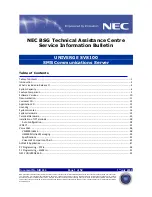
Network Design
Site Planning and Preparation
4-7
Patient
Monitor Type
Another consideration is the type of patient monitor that will be used -- SDN/PCC (hardwired
and/or telemetry), M3/M4 (wired and/or wireless), IntelliVue Patient Monitors, or mixed. For
installations of acute patient care, where patients remain in their beds, hardwired bedside
monitors, either SDN/PCC or Network connected, are generally required. For less acute care
installations, in which patients are ambulatory, SDN/PCC telemetry monitors are generally
required. For installation in which patients may change from bed restricted to ambulatory, both
hardwired and telemetry monitors should be available. And for installations where patient
monitors may be frequently moved from bed to bed, wireless monitors, may be preferred. The
software can accommodate all of these types of installations, providing continuous collection of
monitoring data as patients change beds or from bed restricted to ambulatory.
Central
Monitor Type
The type of central monitor should also be matched to the level of patient monitoring required.
For a detailed discussion of each central monitor’s capabilities, see
Chapter 1
.
Central
Monitoring
Locations
Locations where central patient monitoring will take place. These will generally be in clinical
units where patient beds are located.
Patient Data
Review
Locations
Locations where review of patient data is required. While the Patient Care Network provides
extensive access to patient monitoring data, both within and across clinical units and at multiple
distant locations, there are limitations on the length of cable runs for each network
interconnection. Cable length limitations must be carefully reviewed in selecting patient data
review locations.
Type of Patient
Data Access
The type of access to patient data and monitoring controls at each monitoring location. For
example, does the clinician need to view both real-time and stored patient data from a clinical
unit and/or other clinical units? Will it be necessary to silence alarms or change monitoring
control settings? The answers to these types of questions are critical to the selection of
monitoring hardware and network design. And they have great impact on the effectiveness of
the Information Center system in meeting the needs of clinicians, as well as system cost.
Future
Capability
When designing a Patient Care Network, both present and future requirements should be
considered. While all Patient Care Network components can be upgraded to future capability,
individual component capability can be limited. There are limitations on cable lengths for each
type of component interconnection. Hence, consideration should be given to possible future
growth or requirements in system design. Review this thoroughly with a Service Provider.
Philips
Hardware
Capability
The design also requires a full understanding of the capabilities and limitations of network
components so they can be properly matched to the clinical requirements.
The Clinical Network can collect and display patient monitoring data from both SDN/PCC
connected monitors (hardwired and telemetry), M3/M4 monitors (wired and wireless), and
IntelliVue Patient Monitors and store patient monitoring data for: up to 128 patients monitored
by 8 Information Centers at 8 separate locations and can also accommodate 8 Clients for
viewing data (real-time and stored) at 8 separate locations on the M3154 Database Server and
up to 48 patients monitored by 3 Information Centers at 3 separate locations and can also
accommodate 3 Clients for viewing data (real-time and stored) at 3 separate locations on the
M3169 Small Database Server and viewing of stored patient data from any browser equipped
PC on the hospital’s intranet. From this overview of maximum system capability, smaller, more
limited systems can be designed.
Summary of Contents for IntelliVue Series
Page 152: ...IntelliVue Information Center Application Software 3 22 Software Description ...
Page 442: ...Troubleshooting 7 156 Maintenance Troubleshooting and Repair ...
Page 488: ...Procedure B 12 Web Installation on the Database Server ...
Page 492: ...Procedure C 4 External Modem Installation ...
Page 500: ...Using RAS D 8 Dial In Procedure for Remote Access to Information Center Systems ...
















































